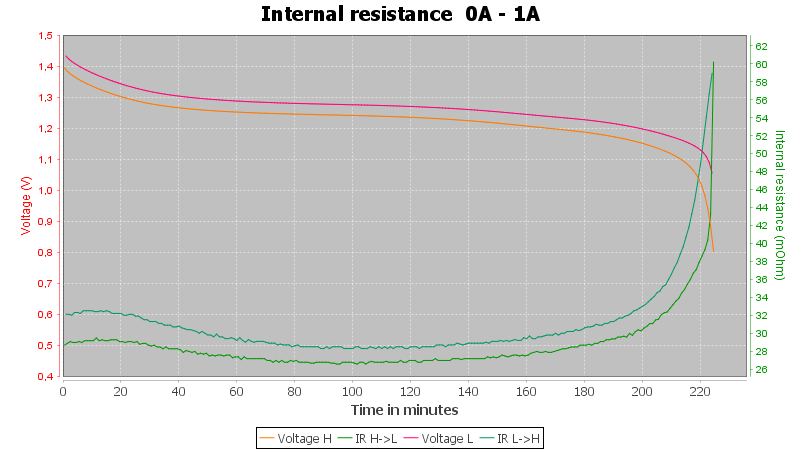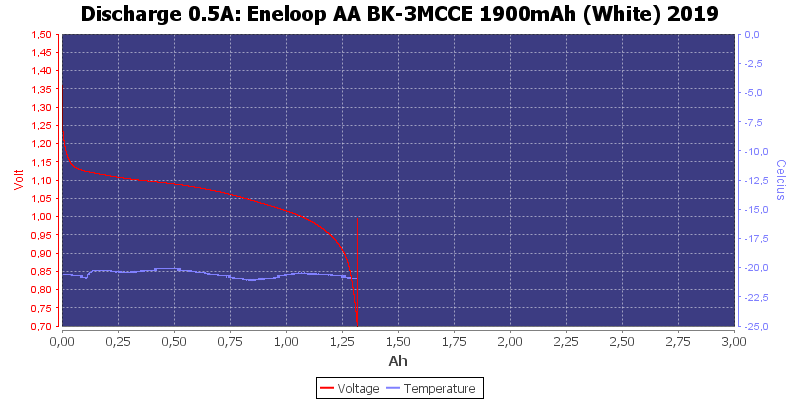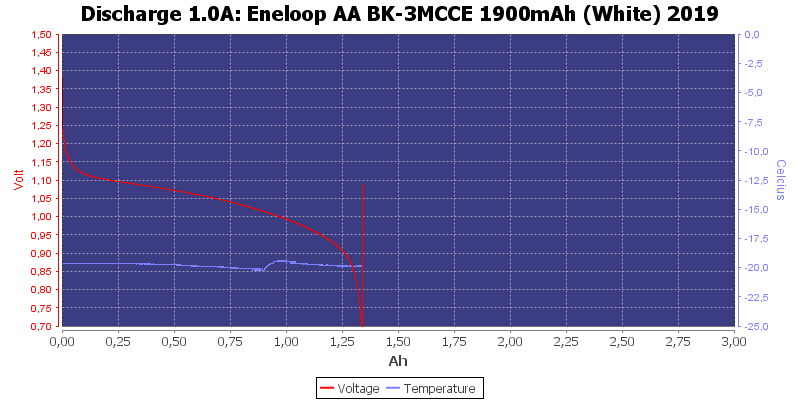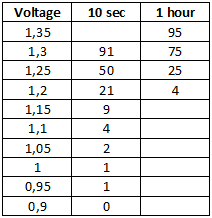Eneloop AA BK-3MCCE 1900mAh (White) 2019
%202019/DSC_7135.jpg)
Official specifications:
- Nominal voltage: 1.2V
- Minimum capacity: 1900mAh
- Low self discharge: 70% capacity left after 10 years
- Cycle life: 2100 cycles.
%202019/Eneloop%20AA%20BK-3MCCE%201900mAh%20(White)%202019-info.png)
Maximum temperature raise at different discharge currents: 1A:+1,5°C, 2A:+3,6°C, 3A:+5,9°C, 5A:+11,3°C, 7A:+16,2°C, 10A:+21,4°C
This is a retest of the standard eneloop (Previous test is from 2016).
%202019/DSC_7105.jpg)
%202019/DSC_7106.jpg)
%202019/DSC_7136.jpg)
%202019/DSC_7137.jpg)
%202019/DSC_7138.jpg)
%202019/DSC_7139.jpg)
%202019/DSC_7140.jpg)
%202019/Eneloop%20AA%20BK-3MCCE%201900mAh%20(White)%202019-Capacity.png)
Fairly standard NiMH discharge curves, the capacity is not record breaking for Eneloops, but they do not self discharge and they last a long time (Except if they are over discharged).
%202019/Eneloop%20AA%20BK-3MCCE%201900mAh%20(White)%202019-CapacityTime.png)
%202019/Eneloop%20AA%20BK-3MCCE%201900mAh%20(White)%202019-CapacityTimeHours.png)
%202019/Eneloop%20AA%20BK-3MCCE%201900mAh%20(White)%202019-Energy.png)
%202019/Eneloop%20AA%20BK-3MCCE%201900mAh%20(White)%202019-PowerLoadTime.png)
%202019/Eneloop%20AA%20BK-3MCCE%201900mAh%20(White)%202019-CurrentTest.png)
%202019/Eneloop%20AA%20BK-3MCCE%201900mAh%20(White)%202019-Charge.png)

Turn a 1A load on/off makes it possible to calculate the internal resistance, here I have done it for a lot of times during a full discharge.
The reason for two curves is that one is calculate from voltage drop when switching load on (L->H), the other from voltage increase when switching load off (H->L).

The eneloop is supposed to work at -20°C and it does, but with reduced capacity and voltage.

The 1A discharge curve looks very similar to the 0.5A curve.
Note: The temperature sensor is not on the battery.

It is usual said that NiMH batteries must be loaded to read capacity, here I have shown remaning capacity in percent based on time after a 1A load is removed. I can see from my data that one hour is not long enough for the battery to recover fully, i.e. the voltage would probably be even worse for estimating capacity after a few hours more rest.
Conclusion
The performance of the eneloop is good and it also works when it is cold.
Notes and links
I am replacing my NiMH charger test batteries, they are from 2016 and some of them has a fairly high internal resistance. Some of the bad chargers I have tested have probably increased the deterioration rate of them.
The extra data in this review is not something I will do in other reviews, except maybe a few IR curves may show up.
How is the test done and how to read the charts
Compare to other AA/AAA batteries: Alkaline/NiMH/Lithium
%202019/DSC_7135.jpg)
%202019/Eneloop%20AA%20BK-3MCCE%201900mAh%20(White)%202019-info.png)
%202019/DSC_7105.jpg)
%202019/DSC_7106.jpg)
%202019/DSC_7136.jpg)
%202019/DSC_7137.jpg)
%202019/DSC_7138.jpg)
%202019/DSC_7139.jpg)
%202019/DSC_7140.jpg)
%202019/Eneloop%20AA%20BK-3MCCE%201900mAh%20(White)%202019-Capacity.png)
%202019/Eneloop%20AA%20BK-3MCCE%201900mAh%20(White)%202019-CapacityTime.png)
%202019/Eneloop%20AA%20BK-3MCCE%201900mAh%20(White)%202019-CapacityTimeHours.png)
%202019/Eneloop%20AA%20BK-3MCCE%201900mAh%20(White)%202019-Energy.png)
%202019/Eneloop%20AA%20BK-3MCCE%201900mAh%20(White)%202019-PowerLoadTime.png)
%202019/Eneloop%20AA%20BK-3MCCE%201900mAh%20(White)%202019-CurrentTest.png)
%202019/Eneloop%20AA%20BK-3MCCE%201900mAh%20(White)%202019-Charge.png)



